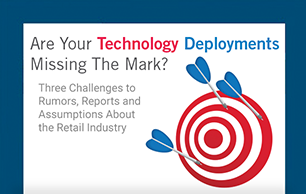
In foodservice and retail, the “front door” is no longer just a door. Guests arrive through delivery marketplaces, catering portals, mobile apps, kiosks, drive-thru windows, and the traditional entrance. Winning brands are not chasing shiny objects, they are aligning brand identity with guest insights and a technology stack that can roll out quickly.
1. Know your guest. Then build your tech stack to act on it.
The starting point is not a tool, it is discipline around guest insights. Every investment, from menu tests to store design, must be grounded in guest signals and each brand’s unique identity. Shared insights may exist at the organization level, but execution has to stay true to each concept.
Critical for success: integrated systems that connect loyalty, POS, digital ordering, kiosks, and back-office platforms.
Without this foundation, insights stay theoretical instead of translating into live guest experiences.
2. Loyalty is the engine of personalization.
Personalization scales once loyalty participation reaches critical mass. With opt-in consent, organizations could use AI-assisted recommendations to match seasonal items, nudge add-ons, and create two-way feedback loops for service and menu testing.
Critical for success: integrated systems that connect loyalty, POS, digital ordering, kiosks, and back-office platforms.
Without this foundation, insights stay theoretical instead of translating into live guest experiences.
3. Orchestrate every “door” consistently.
Guests may arrive via delivery apps, catering platforms, curbside pickup, or the store entrance, yet they expect the same quality of service. The real challenge is orchestration: routing orders, pacing the line, training teams, and keeping recipes and promotions consistent.
Critical for success: a unified POS and digital platform nationwide.
Consistent training, signage, and back-of-house systems ensure that multiple entry points still deliver one experience.
4. Test, pressure-test, then scale.
Successful organizations do not just launch, they pilot, pressure-test, and scale. New apps, features, and programs are trialed in company-operated locations and with select franchise partners before enterprise rollout. This surfaces the real-world friction early, from workflow to signage to kitchen timing.
Critical for success: standardized pilot kits and clear success criteria.
Parallel rollouts paired with a move-and-improve cadence allow speed without chaos.
5. Results worth noting.
Guest satisfaction scores are rising, loyalty accounts for a significantly higher share of sales in some concepts, and a healthy development pipeline is fueled by franchisee confidence in technology investments.
Key Success Metrics:
-
-
- Days from approval to first store live
- Stores activated per week
- Training completion rates
- Uptime and system reliability
-
6. What’s next is speed over perfection.
AI is beginning to show up in practical ways such as suggested selling, smarter routing, training assistance, and store design decisions informed by real-time feedback. Convenience continues to expand through new service models and new dayparts, which increases the demand for high-quality integration.
Critical for success: connective tissue across networks, edge devices, POS, peripherals, and partner integrations.
Iteration must be fast, but not at the expense of store stability.
7. Franchisee-first is brand-first.
Technology that ignores store-level reality will not scale. Successful organizations co-design rollouts with franchise partners, test with real teams, and adapt workflows to ensure profitability and adoption.
Critical for success: install windows that work for operators, streamlined site surveys, and support for day-two realities.
Co-creation with franchisees ensures both buy-in and practical execution.
8. Guardrails that keep teams focused.
Teams stay focused by tying every deployment to a brand promise and guest need, letting data guide which ideas ship first, favoring unified platforms over fragmented point solutions, and moving fast without chasing perfection.
Critical for success: clear guardrails that prevent distraction by “shiny objects” and keep every initiative aligned to customer needs and brand purpose.
Customer-centric innovation is less about tools and more about operating discipline. The organizations that win are the ones that translate guest insight into live experiences consistently and at scale.
Want to move faster?
At this point, the right partner makes the difference. Telaid helps by designing, deploying, and supporting the integrated technology that turns strategy into reality across hundreds or thousands of doors. The next step is a clear path from pilot to live locations. Ready to move faster? Let’s map a 90-day plan from idea to execution.
Get the step-by-step guide to planning faster tech rollouts.
Download Chapter 1 of the Rollout Readiness Framework below to build a technology rollout plan your leadership team can say yes to.




